SEJournal Online is the digital news magazine of the Society of Environmental Journalists. Learn more about SEJournal Online, including submission, subscription and advertising information.
 |
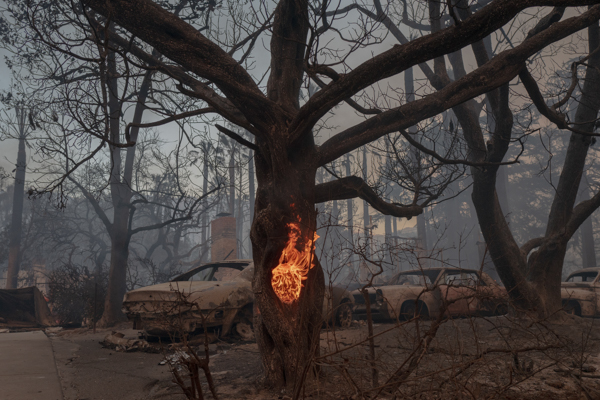 |
| “I was overwhelmed with grief about the state of the world, and the way the climate disasters keep coming in full force,” photographer September Dawn Bottoms told the author about seeking more meaningful images following the Eaton fire in Altadena, California. Photo: September Dawn Bottoms. |
EJ InSight: Can a City on Fire Be Photographed? Yes, Says One Photojournalist
By Andrew Cullen
In January, just a few days after the Palisades and Eaton wildfires exploded to consume vast swaths of Los Angeles and the public consciousness, The New Yorker published an essay by Teju Cole titled “A City on Fire Can’t Be Photographed” (may require subscription). It carried a subtitle: “The images of a burning Los Angeles won’t last, simply because our ways of seeing are inadequate to our predicament.”
In the piece, Cole, a polymath who has published novels as well as several books of photography, argues that images of the fires and other recent disasters are rendered immemorable by the sheer quantity of photographs produced — and shared — during such emergencies. Because the images are a product of the “unremitting public need for novelty,” wherein today’s news is replaced by tomorrow’s with barely a chance for resolution, they “do not invite their use as objects of contemplation.”
It spoke to frustrations photojournalists
know well: The pressure, during disasters,
to make images of substance while
filing multiple times a day.
Cole’s words stuck in my craw, and I spent weeks parsing his essay. It spoke to frustrations I and other photojournalists know well: The unceasing demands and diminishing returns of social media. The pressure, during disasters, to make images of substance while filing multiple times a day, despite the destruction all around. The challenge of demonstrating the ferocity of storms that are somehow both historic and a “new normal.”
“The frequency of these disasters is producing less ‘flashbulb memories’ for the collective,” Kyle Grillot, a freelance photojournalist who covered the Palisades and Eaton fires for Bloomberg and The New York Times, wrote to me. “These images have now become the annual norm for how the news of these fires is typically consumed.”
Navigating the dangers of disaster, in motion
There’s undoubtedly a degree of repetitiveness to wildfire photojournalism. In Malibu, it seemed as though every photographer covering the Palisades fire was compelled to make an image of the same burned structure, reduced to its frame and a spiral staircase, the gleam of the Pacific behind. After every wildfire that intrudes on human settlements comes a stream of pictures of the melted exoskeletons of incinerated cars.
Making photographs while navigating the dangers of a disaster in motion is, of course, difficult. “Conveying the scale of a deadly 100-mile-per-hour fire is really hard. With something so large and dangerous, I feel lucky to come out with anything at all, let alone a single image that tells the story,” Grillot wrote to me. “I do my best while simultaneously keeping my head on a swivel to stay safe, or at least, alive.”
It is even harder to make images
that draw connections between a
singular event — a fire or hurricane
— and the broader context of our times.
It is even harder to make images that draw connections between a singular event — a fire or hurricane — and the broader context of our times, photographs that “speak variously of environmental collapse, policy failure, ineluctable helplessness,” as Cole says.
After the fires, “I was overwhelmed with grief about the state of the world, and the way the climate disasters keep coming in full force,” wrote September Dawn Bottoms, a photographer known for her intimate documentation of complicated family dynamics, in an email. “And so I went out looking for images that would speak to the feeling of ‘this is so much bigger than these tragic fires.’ I spent three or four days going out to both the Palisades and the Eaton fires looking for something that felt that way. This was the only image I got back that felt like anything different.”
In that one photo (at top of page), and in a video clip of the same scene, smoke hangs in the air over a scorched homestead; little appears to have survived. But in the hollow of a tree, flames still dance. The fire could have burned for decades. It might burn eternal. It surely will in Bottoms’ photograph.
“It’s incredibly difficult to photograph an event that is at once singular and a symptom of something bigger,” she wrote. “I think we all go out with that intention because I think the chances of finding it are really rare.”
Getting beyond the tropes
And yet, despite Cole’s headline and the myriad challenges inherent to the task, many photojournalists rushed to Altadena and the Palisades, returning with striking results. In the months since the LA fires and since hurricanes Milton and Helene devastated the Southeast last fall, I’ve revisited some of these images again and again.
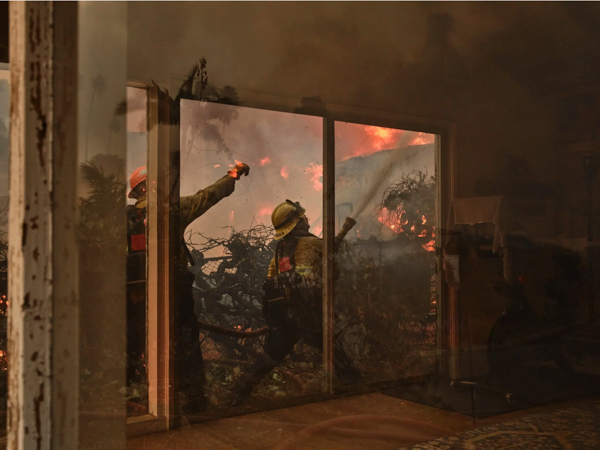 |
| Dangerous winds spread the Palisades fire from wild lands to urban areas in Pacific Palisades. Photo: Philip Cheung for The New York Times. |
In a photograph for The New York Times (above), Philip Cheung captured a dramatically layered scene of firefighters at work. The fire crew is in the middle ground, framed through a glass sliding door in a darkened room. Flames rage into the sky in the background. Or is it the foreground? Cheung made the photo through another window across the room, which reflects the scene behind with the effect that one of the firefighter’s hands appears to be aflame. The fire is all around, and the situation is desperate.
 |
| A fire truck drives into the Palisades Fire in the Pacific Palisades neighborhood of Los Angeles on Jan. 7, 2025. Photo: Bloomberg/Kyle Grillot. |
One of Grillot’s frames (above), streaked with a blizzard of flying embers from edge to edge and a lone fire truck navigating through it, demonstrates the intensity of the firestorm and the peril of trying to navigate it. Ethan Swope’s image, for The Associated Press, of an elder care home’s evacuation reveals frantic energy.
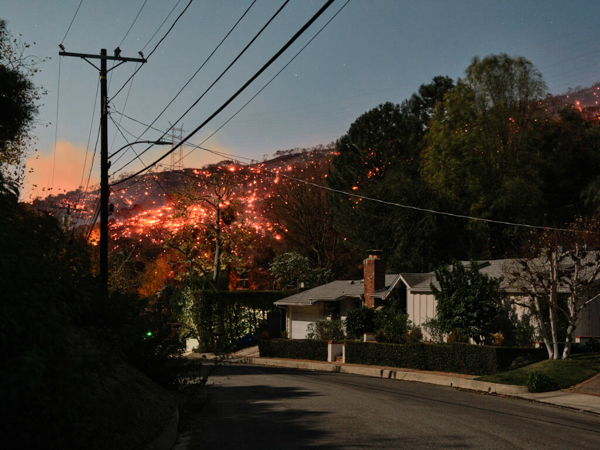 |
| The hills burn above houses during the Palisades Fire in the Mandeville Canyon neighborhood of Los Angeles on Jan. 11, 2025. Photo: Philip Cheung for The New York Times. |
In an image of the fires in Mandeville Canyon by Stuart Palley, the long-exposure tail of water-drop helicopters traces a path between the elemental glow of wildfire and the artificial illumination of the nearby metropolis. One of Cheung’s photos of the same area (above) encapsulates the false security we’ve come to associate with the suburbs, in dusky tones that recall the work of Gregory Crewdson or Todd Hido.
 |
| A man tries to save an American flag during the Eaton Fire in Altadena on Jan. 8, 2025. Photo: Bloomberg/Jill Connelly. |
Working for Bloomberg, Jill Connelly photographed a man removing an American flag from its flagpole (above). There’s a tenderness to the moment, even as the home behind him burns. It’s not hard to find a metaphor for the country’s tenuous state in the image, made just a few days before the onset of Trump’s second term. Or in Sinna Nasseri’s photo of a Tesla Cybertruck driving past an incinerated Chase Bank branch.
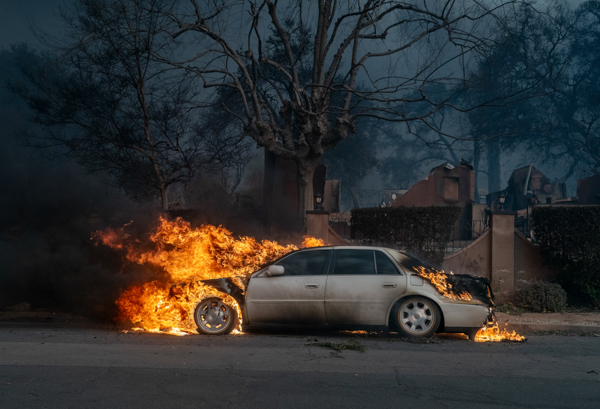 |
| A car burns during the Eaton Fire in Altadena on Jan. 8, 2025. Photo: Kyle Grillot for The New York Times. |
I found other car photos that stood out from the wildfire cliché. In one scene Grillot photographed (above), a sedan’s hood and trunk are engulfed in flames. The middle of the vehicle is smudged with soot, but has yet to burn. In the background lies the toppled ruin of a destroyed home. The past, present and future of the fire appear in one frame.
By simply placing his photos of burned cars in a typological grid, Jay Clendenin, a former LA Times staffer, acknowledges the trope while hinting at the size and scale of the fire’s damage.
Awaiting the aftermath of disaster
For some, the experience of disaster is immediate — fleeing as the flames close in, climbing higher as the floodwaters rise — but many must wait at a distance to find out how much the life they’ve known will be upended.
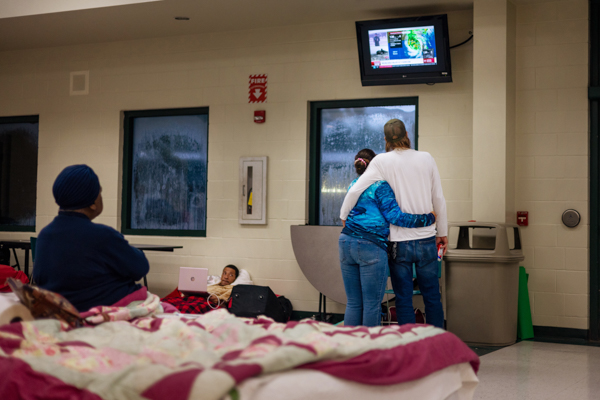 |
| Douglas Gajus and his wife Tara watch the news as they wait for the arrival of Hurricane Helene at Lincoln High School, which was opened as a shelter in Tallahassee, Florida, Sept. 26, 2024. Photo: Reuters/Kathleen Flynn. |
Working for Reuters, Kathleen Flynn made as complete of a photo as I have seen of that liminal experience, at a shelter during Hurricane Helene (above): A couple and two other people share the frame and the moment, together and yet also isolated, while rain streaks the windows and the television newscast tracks the storm.
After Hurricane Helene, Christian Monterrosa (may require subscription) followed residents of Bat Cave, North Carolina, delivering essential aid via raft, and a woman and her fiancé hiking to a nearby mountain settlement to bring supplies to her stranded parents. Human-powered transportation, now associated most strongly with recreation, had been rendered necessary for survival.
Paul Ratje photographed the aftermath of both hurricanes with a drone, allowing the viewer to see the destruction from the perspective of the storm itself. In one, tall grass cradles a detached roof in Florida’s Big Bend region. The scene appears almost gentle until the realization dawns that this structure is not meant to be here.
Jefferee Woo, a Tampa Bay Times staffer, made an image of a local woman surveying her water-damaged home. Every table and stool is covered in an attempt to keep things dry. The woman’s overwhelmed posture is at odds with the figure printed on her T-shirt: pumping iron, strong.
To document and inform
In his essay, Cole writes about the history of landscape art and early appearances of infernos. “Paintings of landscapes on fire typically illustrated Biblical or religious scenes. Divine retribution was a central theme, but the possibility of escape was often embedded. Because there was more to these paintings than doom, they could be looked at contemplatively; and because they luxuriated in anecdotal, often fantastical detail, they could also be looked at for pleasure.”
Our primary responsibility is to document
and inform the communities that are
experiencing these events directly, and the
communities who may experience them soon.
Photojournalism can and sometimes does rise to the level of art. But it’s important to remember that its core function is something else. When it comes to natural disasters (and the changes to climate that increasingly enhance them), we may record a first draft of history. But our primary responsibility is to document and inform the communities that are experiencing these events directly, and the communities who may experience them soon — whether the resulting images are iconic or not.
“I haven’t seen a single image that tells the whole story” of the LA fires, Connelly wrote in an email. “But as a collective body of work, photographers documenting these fires tell a powerful story of mother nature’s unstoppable power combined with human failures. The photos form a collective portrait of two diverse, grieving and resilient communities in LA.”
In a conversation over Zoom, Flynn emphasized that disaster coverage isn’t contained to the event itself. “A more effective and I think important part of what we do — an important part of the coverage of climate change — is staying with the story over time and not just being there for that one … life-changing moment. It's years of recovery and rebuilding.”
In that follow-up, “You can add the depth of people's lives and show them as they're unfolding after such a catastrophe, and show the different ways that their lives are impacted. I think that's when people get really engaged.”
And if disaster photos may not provide pleasure, they can provide value in other ways.
“During Katrina, one of my pictures ran on the cover of Time,” Flynn said, referring to an image of a woman, Sadie James, “pushing her mom in a wheelchair through the floodwater.” The light is harsh and direct, and the composition isn’t complex like a Renaissance painting. But, Flynn says, “the impact it had on her life seemed to be pretty profound.”
“She was like, ‘This is the proudest moment in my life. I was saving my mom.’”
When Flynn visited James later, “She had it up on her wall.”
Andrew Cullen, editor of SEJournal’s EJ InSight, is an independent photojournalist whose work examines the complicated relationships between the environment and individual and communal identities. A 2022-2023 Ted Scripps Fellow for Environmental Journalism at CU Boulder, he has photographed for The New York Times, NPR, CNN, Reuters and High Country News.
* From the weekly news magazine SEJournal Online, Vol. 10, No. 16. Content from each new issue of SEJournal Online is available to the public via the SEJournal Online main page. Subscribe to the e-newsletter here. And see past issues of the SEJournal archived here.








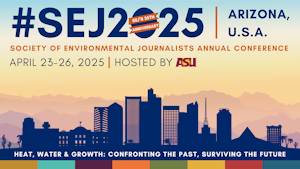




 Advertisement
Advertisement 



